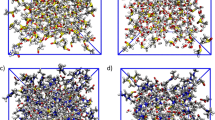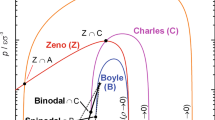Abstract
The mathematical formalism for description of solute interactions in dilute, multicomponent solutions should be consistent with (a) the Gibbs-Duhem relations and associated thermodynamic definitions and (b) the principle of regularity of dilute solutions due primarily to Darken. Wagner's original suggestion that Inγ i and Inγ j be represented by Taylor's series expansions, withε i (j) = εj (i), meets both these criteria if and only if both first and second order terms are included, with second order coefficients equal to the negatives of the first order coefficients, as in the Darken quadratic formalism. The resulting Wagner-Darken quadratic formalism can be modified for better fit to some experimental data, without loss of rigor, by different choices of components and different definitions of activity coefficients. The recent conjectures of Sukiennik and Olesinski about the thermodynamic validity of the original Wagner formalism are addressed briefly.
Similar content being viewed by others
Abbreviations
- a :
-
activity of a solution component
- G E′ :
-
excess Gibbs free energy, extensive property
- G E :
-
molal excess Gibbs free energy
- n i :
-
number of moles
- R :
-
gas constant
- T :
-
absolute temperature
- X i :
-
mole fraction
- Y i :
-
moles
- i :
-
per mole solvent
- α ij :
-
Darken interaction parameters
- ε i )j) :
-
Wagner interaction coefficients
- γ i, γi′:
-
activity coefficients
References
M.Z. Sukiennik and R.W. Olesinski:Metall. Trans. B, 1984, vol. 15B, pp. 677–80.
R. Schuhmann, Jr.:Acta Metall., 1955, vol. 3, pp. 219–26.
N. A. Gokcen:J. Phys. Chem., 1960, vol. 64, pp. 401–06.
C. Wagner:Thermodynamics of Alloys, Addison-Wesley Press, Cambridge, MA, 1952, pp. 47–53.
L. S. Darken:Trans. TMS-AIME, 1967, vol. 239, pp. 80–89.
L.S. Darken:Trans. TMS-AIME, 1967, vol. 239, pp. 90–96.
C.H.P. Lupis and J.F. Elliott:Acta Metall., 1966, vol. 14, pp. 529–38.
J. Chipman:Trans. TMS-AIME, 1967, vol. 239, pp. 1332–36.
R. Schuhmann, Jr., P.-C. Chen, P. Palanisamy, and D. H. R. Sarma:Metall. Trans. B, 1976, vol. 7B, pp. 95–101.
H.H. Kellogg:Physical Chemistry in Metallurgy, Proc. Darken Conf., U.S. Steel Research Lab., Monroeville, PA, 1976, pp. 59–68.
Author information
Authors and Affiliations
Rights and permissions
About this article
Cite this article
Schuhmann, R. Solute interactions in multicomponent solutions. Metall Trans B 16, 807–813 (1985). https://doi.org/10.1007/BF02667517
Received:
Issue Date:
DOI: https://doi.org/10.1007/BF02667517




